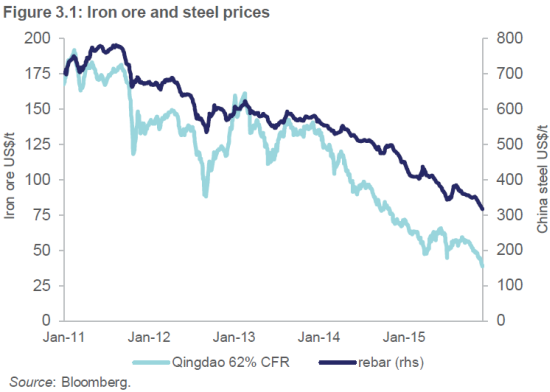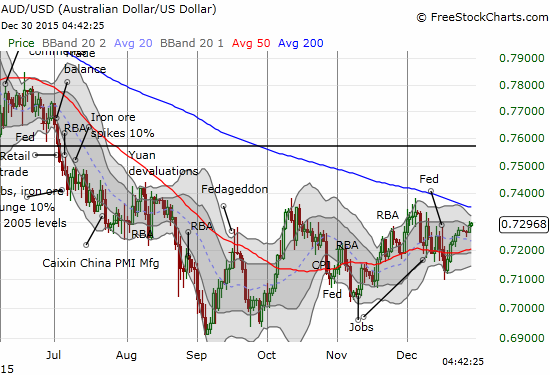Australia’s Department of Industry, Innovation and Science recently released its latest Resources and Energy Quarterly. As usual, I was most interested in the projections for iron ore and the Australian dollar.
The Department has been over-optimistic in the past about iron ore. This time around, the Department slashed forecasts in what sounds like another disappointing year for the key ingredient for steel. From the December, 2015 quarterly:
“…As a result of the unexpected pace of the iron ore price decline, the forecast iron ore price for 2016 has been revised down to $US41.30 a tonne.”
At the time of writing, iron ore is around $42.31 per tonne. Iron ore is experiencing a nice relief rally to close out the year: eight straight days with gains since hitting a record low of $38.30 per tonne on December 11th. Given most iron ore producers remain committed to producing as much as they can, I fully expect iron ore at some point to dip well below the Department’s average forecast before recovering to hit the target.
This chart (from page 19 of the quarterly) mapping Chinese steel rebar prices and iron ore says everything. The trend still points toward more losses..

Source:
The projected low price for 2016 will hurt Australia’s export performance:
“In 2015-16, Australia’s export earnings from resources and energy commodities are forecast to decline by 4 per cent to $166 billion as an increase in export volumes, particularly LNG and iron ore, are more than offset by lower prices…
In 2015-16, Australia’s iron ore export volumes are forecast to increase by 9 per cent to 818 million tonnes, supported by higher production at existing mines and the commissioning of the Roy Hill mine in December 2015. With prices forecast to be 36 per cent lower on average in 2015-16, iron ore export values are forecast to decline by 14 per cent to $47 billion.”
Over the past year, Australia has pushing a lot of ore into a very bad market:
“Global trade in iron ore is estimated to have increased by 1.8 per cent in 2015 to 1.4 billion tonnes, the lowest rate of growth since 2001.”
The Department’s somber outlook on iron ore at least partly comes from an acceptance of China’s somber outlook on the domestic steel industry:
“The China Iron and Steel Association estimate that at current prices, only 4 per cent of China’s steel producers are profitable. The price of steel is forecast to remain subdued through 2016 as excess capacity and low consumption growth continue to affect China’s steel market.”
If 2016 is not the year of major bankruptcies in China’s steel industry, then we know the government is still furiously trying to pump in support. I am not clear whether the Department’s forecast for iron ore includes some anticipated contraction in Chin’s steel industry. Certainly, at this poor level of profitability, anyone building forecasts off current production levels may soon become severely disappointed.
With iron ore expected to put in another poor performance, it is no surprise that the Department is relatively somber about the prospects for the Australian dollar (emphasis mine):
“The Australian dollar has depreciated against the US dollar over the past twelve months and has returned to levels last recorded in 2009-10. The combination of forecast lower commodity prices and relatively low interest rates are likely to result in further falls in the value of the Australian dollar over the course of 2016. For this set of forecasts the Australian dollar is assumed to average 0.71 US dollars per Australian dollar in 2015-16. However there is considerable risk that Australian dollar could fall further over the period.”

Source: FreeStockCharts.com
I am inclined to believe the scenario of “considerable risk.” As 2016 wears on without any relief in sight for iron ore and steel, the Australian dollar should invite a lot more sellers. The Reserve Bank of Australia (RBA) is the on-going wildcard. An article from CNBC also cites recent M&A activity as well as deals in commercial real estate as drivers supporting demand for Australian dollars. This frenzy of activity cannot continue to stave off commodity-related weakness for long…
Source: CNBC
Be careful out there!
Full disclosure: net short the Australian dollar
